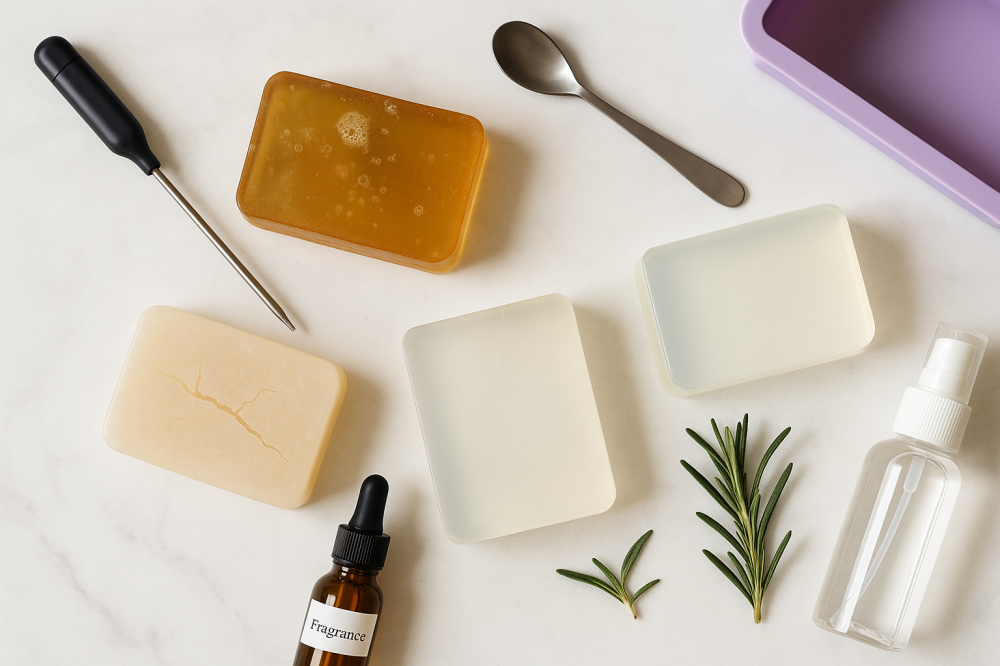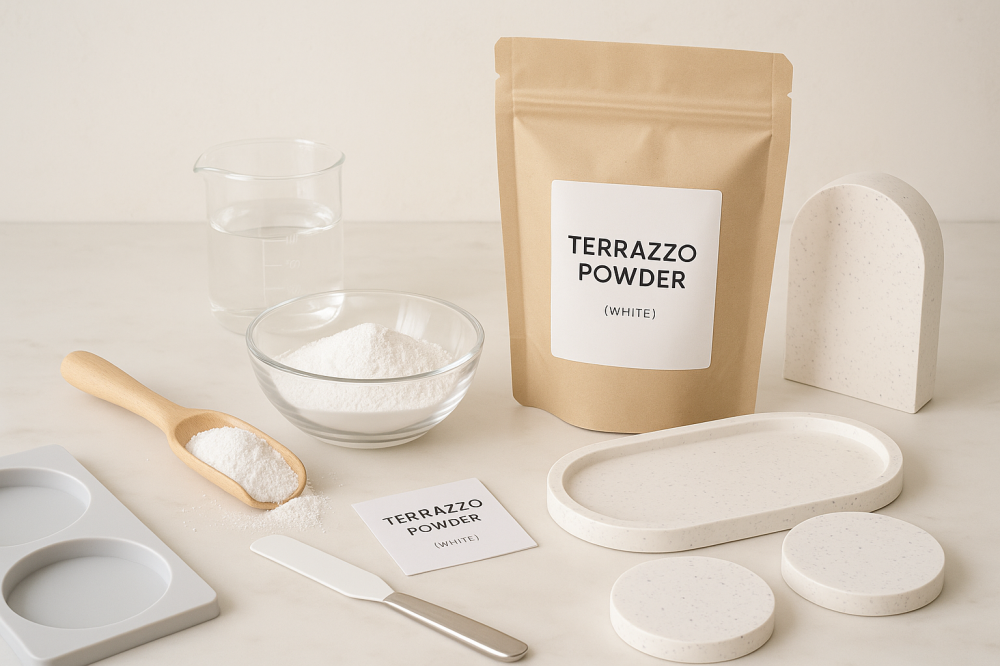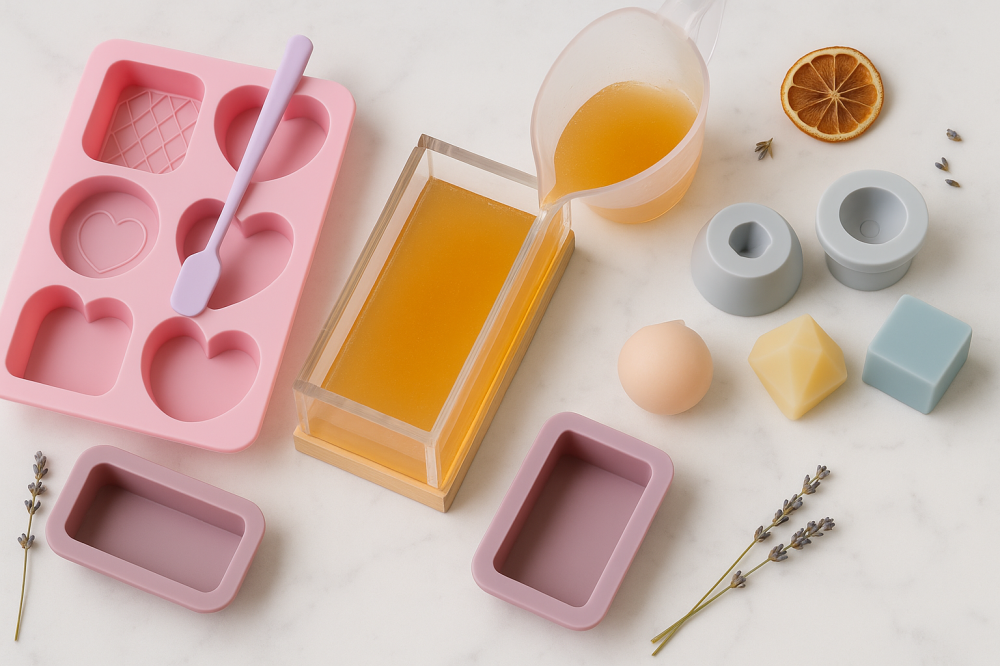Disposable and pourable glycerin soap is easy and delicious—but—a few small mistakes can ruin the look or the scent. Here's a practical guide focusing on three main problems and how to prevent them in the first place, with quick fixes if they do occur.
Before you begin: 3 golden rules
- Temperature control: Gentle melting between 60–75°C , and pouring close to 55–60°C .
- Gentle stirring: Vigorous stirring traps air and weakens the surface.
- Quick packaging and climate-controlled storage: prevents "sweating" and maintains appearance.
1) Burning (burnt smell, yellowing, sudden cloudiness)
Why does this happen?
- Overheating or boiling of the base.
- Long microwave melting time without cutting or stirring between periods.
- Overheating the same batch.
How do you detect it?
- A “burnt” scent, a dark or opaque layer instead of clarity.
- Unnaturally thick consistency despite the heat.
Prevention
- Cut the base into cubes and melt it in a water bath or by intermittent heating with light stirring.
- Stop when it melts, do not let it boil .
- Lower the temperature to 55–60°C before adding the color and fragrance.
Rapid ambulance
- If you notice a slight burning smell: mix immediately with a fresh base (1 part burnt: 2-3 parts fresh) to reduce the effect.
- If the color changes too much: use it as a thin base layer or remelt it with a white base to make an opaque piece.
2) A faint odor (disappeared or barely noticeable)
Why does this happen?
- Using a perfume not intended for soap.
- Adding less than 1% or more than necessary weakens the texture.
- Adding perfume and a very hot base causes part of the fragrance to evaporate.
- Store the pieces uncovered before packaging.
Prevention
- Use essential oils specifically formulated for soap and safe for the skin.
- Typically, adhere to 1–2% of the base weight.
- Add the perfume at 55–60°C with gentle stirring for even distribution.
- Wrap immediately after hardening to lock in the scent and prevent it from escaping into the air.
Rapid ambulance
- For a finished piece with a faint scent: Melt a very thin layer of scented base in a controlled ratio, and pour it over the surface as a “scented cap”.
- Do not raise the percentage arbitrarily; excessive perfume may loosen the garment or cause skin irritation.
3) Cracks (broken surface or internal cracks)
Why does this happen?
- Fast cooling (direct fan, refrigerator/freezer).
- A high perfume content affects the stability of the base.
- Pour a new layer while it is hot, and it will melt the layer underneath and then shrink.
- Early removal from a solid (acrylic) mold before full hardening.
Prevention
- Cool in a quiet, air-conditioned room away from drafts.
- Keep the perfume content within 1–2% .
- For the layers: wait for a surface crust and then pour the next one at 55–60°C .
- With acrylic: Allow enough time for it to harden before unscrewing.
Rapid ambulance
- For surface cracks: Pass very mild heat (hair dryer on coolest setting or a quick touch of hot air from a distance) just to smooth the surface—very carefully.
- For deeper cracks: Melt a small amount and pour a thin layer to seal the crack, or re-pour completely if the damage is extensive.
Related problems you might see with these errors… and their quick fixes
- Too many bubbles: Pour from near the surface and spray with 70% medical alcohol immediately after pouring.
- Cloudiness in clear without burning: Excessive color or solid/water additives; dilute the color and avoid non-intended liquids.
- “Sweating” (dew): Wrap immediately after unpacking and store in an air-conditioned, dry place—and keep away from the freezer.
Pre-production checklist
- Melting point 60–75°C … and pouring point 55–60°C .
- The fragrance is intended for soap at a rate of 1-2% .
- Gently stir and pour from a low height .
- Layers: Light rind + spray alcohol between each two layers.
- Cooling in an air-conditioned environment, then immediate packaging .
Summary
Most problems with glycerin soap will disappear once you adjust the temperature , maintain the correct fragrance ratio , and provide gentle cooling . If a mistake does occur, act quickly with the simple solutions above, and you'll maintain a clean appearance, a balanced fragrance, and a durable piece ready for sale or gifting.




